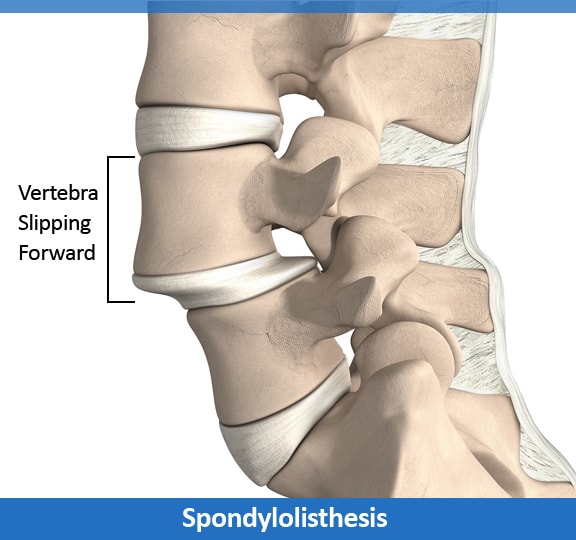Spondylolisthesis is divided into five major types based on the location and cause of the condition.
1. Pathologic
This type of spondylolisthesis is caused by weakness of the bone, due to a disease, a tumor, or other diseases of the bone.
2. Dysplastic
This type of spondylolisthesis is caused by a birth defect resulting in abnormal facet formation.
3. Isthmic
Spondylolisthesis of this type is caused by a defect in a part of the vertebra called the pars interarticularis.
4. Degenerative
Degenerative spondylolisthesis is due to arthritis causing misalignment of the spine.
5. Traumatic
This type of spondylolisthesis is caused by trauma to the vertebrae. A fracture of the pedicle, lamina, or facets can cause the vertebra to slip forward.
Spondylolisthesis

What is Spondylolisthesis?
Spondylolisthesis occurs when one vertebra slips and moves forward in relation to the vertebrae beneath it. It usually occurs in the lumbar and sacral regions. The slippage is forward and usually results in a gradual deformity of the lower spine and a narrowing of the vertebral canal. When the vertebra slips backwards instead of forward, this is called retrolisthesis. Pain in the back and legs are common.
Patient Education Video
Types of Spondylolisthesis

What Are the Signs and Symptoms of Spondylolisthesis?
The most prevalent symptom of spondylolisthesis is lower back pain. Leg and buttock pain or weakness, bladder or bowel problems, tight hamstring feeling, swayback or protruding abdomen are other symptoms of the condition. And many people have no symptoms whatsoever.
The degree of pain a person will experience is not always correlated with the degree of slippage. Those with spondylolisthesis may associate an injury with the onset of their symptoms.
In addition to back pain, someone with a spondylolisthesis may complain of leg pain due to nerve root irritation as a result of a narrowing of the openings that allow the nerves to pass through.
The degree of pain a person will experience is not always correlated with the degree of slippage. Those with spondylolisthesis may associate an injury with the onset of their symptoms.
In addition to back pain, someone with a spondylolisthesis may complain of leg pain due to nerve root irritation as a result of a narrowing of the openings that allow the nerves to pass through.
How is it Diagnosed?
Many people with spondylolisthesis will have mild symptoms and very little visible deformity. Often, the first physical sign of spondylolisthesis is a tightening of the hamstring muscles in the legs.
Plain X-Rays of the lumbar spine are best for diagnosing spondylolysis or spondylolisthesis. Spondylolisthesis is readily seen on the lateral and oblique views of the spine. In some cases, a CT scan (CAT scan) is needed to make the diagnosis. People with dysplastic pars have an elongated interarticular region along with altered pedicles which is best seen by CT. Flexion and extension X-Ray views of the lumbar spine help to identify the instability (abnormal motion) of the spine. It may be that there is only pain with flexion or extension.
Spondylolisthesis is graded according to the degree of slippage of one vertebral body compared to the one beneath it:
Plain X-Rays of the lumbar spine are best for diagnosing spondylolysis or spondylolisthesis. Spondylolisthesis is readily seen on the lateral and oblique views of the spine. In some cases, a CT scan (CAT scan) is needed to make the diagnosis. People with dysplastic pars have an elongated interarticular region along with altered pedicles which is best seen by CT. Flexion and extension X-Ray views of the lumbar spine help to identify the instability (abnormal motion) of the spine. It may be that there is only pain with flexion or extension.
Spondylolisthesis is graded according to the degree of slippage of one vertebral body compared to the one beneath it:
- Grade I – Less than 25 percent slippage
- Grade II – Between 25 and 50 percent slippage
- Grade III – Between 50 and 75 percent slippage
- Grade IV – More than 75 percent slippage
- Grade V – The upper vertebral body has slipped all the way off the front of the lower vertebral body. This is a rare situation that is called a spondyloptosis.
How is it Treated?
If there are minimal symptoms, then nothing needs to be done for spondylolysis and spondylolisthesis. Keeping active and exercising is important while short courses of rest and anti-inflammatories may be necessary for symptoms such as pain. A physical therapist is often helpful in instructing the proper way to do exercises without making symptoms worse. Braces are rarely needed but might help some symptoms. Combination anti-inflammatory and cortisone injections are used on occasion.
Surgery to repair certain defects in the pars interarticularis may be needed if non-surgical measures have not worked. In patients with an instability of the spine, a spinal fusion may be recommended. The primary objective is to relieve pressure on the nerves while making the spine more stable.
Due to recent advancements in motion-preserving spine surgery, patients with Spondylolisthesis may be able to avoid spinal fusion with Artificial Disc Replacement (ADR) (cases of Grade 1 or less) or Total Facet Joint Replacement to realign the spine and restore healthy movement.
Surgery to repair certain defects in the pars interarticularis may be needed if non-surgical measures have not worked. In patients with an instability of the spine, a spinal fusion may be recommended. The primary objective is to relieve pressure on the nerves while making the spine more stable.
Due to recent advancements in motion-preserving spine surgery, patients with Spondylolisthesis may be able to avoid spinal fusion with Artificial Disc Replacement (ADR) (cases of Grade 1 or less) or Total Facet Joint Replacement to realign the spine and restore healthy movement.
Surgery & Treatment for Spondylolisthesis
At Spine Connection we have regenerative and surgical treatments for all spine conditions. As every case is unique we encourage you to receive and compare opinions from our Neurosurgeon and Orthopedic Spine Specialists. We are here to help.
Begin My Assessment
Ask Our Doctors
Join Our Youtube Channel
Watch videos showcasing the latest technologies and surgery techniques, and keep up to date with patient stories from around the globe.








